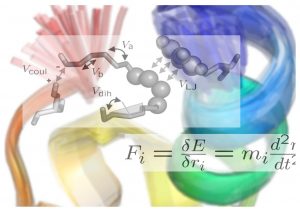WS 2019/20: Lectures and Hands-on sessions in computational molecular biophysics

How can a bird sense magnetic fields, how does our ear detect sound waves, how does our bone feel gravitation? It is the physics of individual molecules that dictate these and many other processes in life. This course introduces computational methods to study the structure, dynamics and mechanics of biomolecules at different scales. It aims at endowing the students with an active understanding of the principles, the capacity and limitations of different molecular simulation techniques, including Monte Carlo, Molecular Dynamics, Brownian Dynamics and multi-scale simulations with an emphasis on Molecular Dynamics simulations. The course comprises alternating lectures and hands-on computer tutorials of which the latter are meant to directly demonstrate the principles of running and analyzing computer simulations of biological matter. Lectures will be given by Prof. Frauke Gräter and Prof. Rebecca Wade. The lectures will be targeted to advanced Bachelor, Master and interested PhD students and will be complemented by hands-on computer sessions in which the students will have the opportunity to run molecular simulations.
Time and place:
Lectures and hands-on computer tutorials will take place in room number 3.103 in Mathematikon. The lectures/tutorials will take place once a week, on Thursdays, 2.30-4 pm (2 SWS). The first lecture will be on October 17th.
Schedule:
| Date | L/P | Topic | Lecturer | |
| 17.10. | L | Introduction: Proteins & Molecular Dynamics | FG | |
| 24.10. | L | Molecular Dynamics and force fields | FG | |
| 31.10. | P | MD: argon in a box | ||
| 7.11. | L | Monte Carlo methods, non-equilibrium methods | FG | |
| 14.11. | P | MD: ubiquitin | ||
| 21.11. | L | Free energy calculations | FG | |
| 28.11. | P | MD: ubiquitin continued | ||
| 5.12. | P | MD: ubiquitin pulling | ||
| 12.12. | L | Coarse-grained and multi-scale MD | FG | |
| 19.12. | L | Continuum electrostatics | RW | |
| 9.1. | P | Continuum electrostatics | ||
| 16.1. | L | Brownian Dynamics | RW | |
| 23.1. | P | Brownian Dynamics | ||
| 30.1. | L/P | Finite element methods & DNA | FG | |
| 6.2. | Question & Answers |